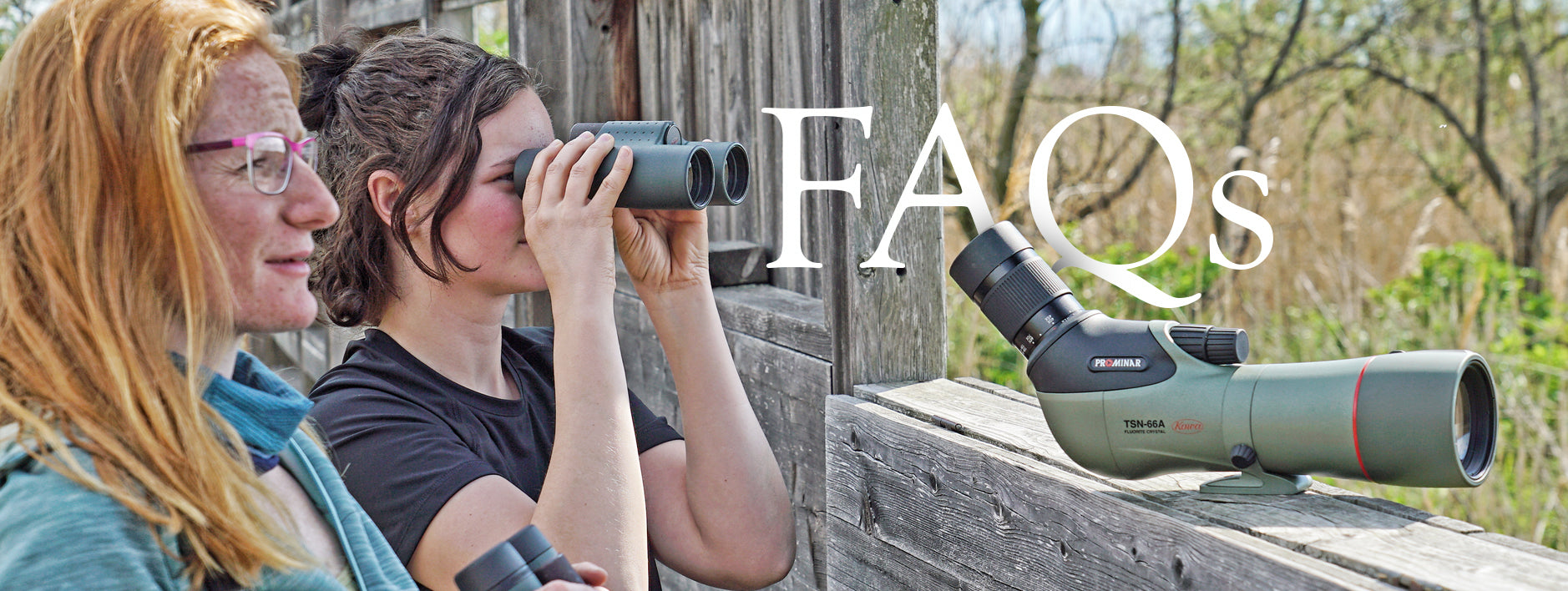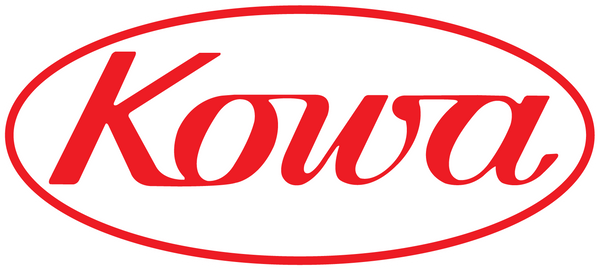
Please browse some of the most frequently asked questions. If you can't find the information you are looking for then please contact us.
Kowa FAQs
Q. Who is Kowa?
Kowa was founded in Japan in 1892 and has been manufacturing sporting optics since 1952. Kowa works in a variety of industries including pharmaceuticals, chemicals, textiles, real estate and more. Kowa American Corporation is headquartered in New York, New York. The Torrance, California branch focuses on ophthalmic diagnostic equipment, machine vision and factory automation lenses, and of course, sporting optics.
Q. What is "PROMINAR"?
Kowa's PROMINAR line of products all feature enhanced optical lenses - Pure Fluorite Crystal. Kowa's PROMINAR Pure Fluorite Crystal is lab grown and then cut, machined, and hand polished in our Japanese factory. Pure Fluorite Crystal can be found in Kowa's PROMINAR spotting scopes series and PROMINAR High Lander binoculars.
Q. What is Kowa's warranty policy?
Kowa offers a Limited Lifetime Warranty, subject to normal wear and tear, to its original owner when purchased from an authorized North American Kowa retailer. This covers any and all manufacturer defects for the life of the product. If there is accidental damage that needs to be addressed, we can service/repair those at our facilities at a cost. To expedite warranty claims, please be sure to register your product at: https://kowaoptics.com/pages/warranty-registration. For any additional questions regarding the warranty of Kowa products, please email us at customerservice@kowa.com.
Warranties vary between our international branches. If you have purchased an optic from another country, please reference the link below for our Japan and Germany branches for more information:
https://kowaoptics.com/pages/kowa-around-the-world
For full warranty information, please visit the page below:
https://kowaoptics.com/pages/full-limited-lifetime-warranty-page
Q. My Kowa optics needs to be serviced, what do I need to do?
The repair process begins with the issuance of an RMA (Return Merchandise Authorization) number. To obtain an RMA#, please visit the link below and complete the fields:
https://kowaoptics.com/pages/service-and-repairs
You can also call our main office at (310) 327-1913 or toll-free (800) 966-5692 between our normal business hours of Monday through Friday, 8:30am - 4:30pm PST.
Once your information is received the service department will create the RMA and email it to you. This will come through from billing@kowa.com and the RMA will be in the .pdf attachment. Please print this sheet and include it in the shipment back to us.
Once received, the service team will review the optic and then reach out with an estimated return time and let you know if there are any costs associated with the repair. No work is completed without prior consent and approval, including valid credit card information if applicable. The total repair time is generally 2-3 weeks from the time the product is received assuming all parts are in stock.
For additional information, please visit the link below and reference the section "Repair Process":
https://kowaoptics.com/pages/full-limited-lifetime-warranty-page
Q. I lost the cap to my ____, where can I buy another?
If the part is still in stock, we are happy to send one replacement at no cost within the US and Canada! Please visit https://kowaoptics.com/pages/service-and-repairs and complete the fields and we will mail those out via USPS. Additional sets or caps can be purchased at a cost.
Q. Where I can purchase your products?
Please visit our Dealer Locator to find a retailer near you. Our products may also be purchased online through major optics retailers. You can also purchase directly on this website or via our listings on Amazon under Kowa Sport Optics. Products must be purchased through authorized dealers/retailers in North America to receive Kowa American Corporation's Limited Lifetime Warranty.
Q. Do you offer special discounts for military, law enforcement, first responders, non-profits, conservation programs, guides, etc.?
Yes! For these customers specifically we offer a direct discount on our products. For a quote, please reach out via the “SUPPORT” tab and then “SERVICE, REPAIRS, AND GENERAL INQUIRIES”. You can also email us at customerservice@kowa.com.
Q. I am interested in becoming a dealer, what do I have to do?
Please email us at customerservice@kowa.com or fill out our Contact Us form, and a sales associate will contact you directly. You may also call us at (310) 327-1913 or toll-free (800) 966-5692 between our normal business hours of Monday through Friday, 8:30am - 4:30pm PST.
Q. Which spotting scopes can be used for digiscoping?
The vast majority of our spotting scopes can be used for digiscoping with our own camera adaptors or third-party solutions.
・TSN-99/88/66/550 PROMINAR series
・TSN-880 series (discontinued)
・TSN-770 series (discontinued)
・TSN-820M/TSN-820 series (discontinued)
NOTE: The TSN-820 series spotting scopes would require a universal smartphone adaptor.
・TSN-1,2,3,4 series (discontinued)
NOTE: The TSN-1/2/3/4 series scopes would require a current eyepiece (TE-9Z or TE-14WD to utilize our TSN-PA8 adaptor. For smartphones, there are a variety of adaptors that would be compatible with the TE-9Z/TE-14WD. For eyepieces original to the spotting scope, a universal smartphone adaptor would be required.
・TSN-660M series (discontinued)
・TSN-600 series (discontinued)
・TS-610 series (discontinued)
Q. What is needed to attach a digital camera to a spotting scope?
Accessories may vary depending on the model spotting scope. To view all our digiscoping accessories, please click here.
Q. Which camera brands can I use with my Kowa spotting scope?
Kowa manufactures T-rings/camera mounts with the following brands: Canon, Micro Four Thirds mounts, Nikon, Pentax K, Sony "A".
Q. Can I connect my phone to my spotting scope or binoculars?
Absolutely! There are a variety of third-party products for connecting your smartphone to your Kowa optic.
Q. What is the focal length of the digiscoping system?
The focal length of a digiscoping system can be found using the following equation:
Focal Length = Focal Length of the Digital Camera x Magnification of the Eyepiece
Q. What is the collimation method?
The method of taking photographs through a digital camera that is attached to the eyepiece of a spotting scope is called the collimation method. Collimate means the aligning of the optical axis of the optical system.
Usually, we look through a telescope/spotting scope through the eyepiece with our eye. When the human eye is replaced by a digital camera to look through the eyepiece to take a photograph, it is called the collimation method.
Q. Which is better, binoculars or spotting scopes?
Both eyes are used to look through binoculars while one eye is used to look through a spotting scope. Generally, spotting scopes have a much higher magnification than binoculars, so far away images appear larger.
But a better three-dimensional image can be expected from binoculars, and they are easier to handle and have better portability.
Q. What is magnification?
Magnification describes how many times closer an image appears. Magnification is also called "power" and is abbreviated by the symbol "x". A magnification of 20 (20 power) means that an object appears twenty times closer than you would see it with the naked eye. When looking through an optic with a magnification of 20x, an object at a distance of 100 yards /meters appears to be only 5 yards/meters away.
Q. What is the actual field of view (angle of view)?
Actual field of view is the view when looking through an optical device indicated by the angle from the center of the objective lens. An optical device with a wide angle of view makes it easier to find an object. In general, it is more difficult to find an object with an optical device with a higher magnification.
Q. What is a field of view at 1000m (1000yds)?
Field of View (FOV) is the width in yards/meters that can be seen at 1,000 yards/meters.
FOV equals the real angle of view x 52.4'. Every degree of real angle of view can see 52.4' at 1,000 yards/meters.
Q. What is objective lens diameter?
The measurement in mm of the diameter of the objective lens of an optic. As the diameter of the objective lens increases, the optic will have better light gathering and higher resolution.
Q. What is an exit pupil?
Exit pupil is the bright circle that is visible when the ocular lens is viewed at a distance of about 25 cm (10 in.) with the objective lens facing towards a bright background or light source. The larger the exit pupil, the brighter the image will be under low-light conditions.
Exit pupil = Objective lens diameter ÷ Magnification
Q. What is resolution?
Resolution, or ultimate sharpness, is the measure of the ability of a spotting scope or binocular to distinguish fine details. Optical glass is at its sharpest in the center, while resolution decreases toward the edges in relationship to the quality level of the lens. Larger objective lenses (with quality as a constant) tend to improve resolution. This is because they have a larger amount of sharp, center objective lens area, as opposed to the amount of lesser sharpness at the edge of the lens surface.
Q. What is minimum focus distance?
The closest distance to an object that the binocular/spotting scope will focus sharply.
Q. What is eye relief?
Eye relief is the distance, measured in mm, between the eyepiece lens to where the exit pupil is actually positioned in space (where the pupil of the eye must be positioned for a full view). A long eye relief makes observing for long periods of time easy and tireless.
Q. What is multi-coating?
When light enters a lens or prism, light is reflected from their surface at a rate of about 4%.
This reflection diminishes the brightness of the optic and causes flare or ghosting.
By coating the surface of the lens, the amount of reflection can be minimized, decreasing flare and ghosting.
Different Types of Coatings:
Coated optics: one or more surfaces coated.
Fully coated: all air-to-glass surfaces coated.
Multi-coated: one or more surfaces are multi-layer coated.
Fully multi-coated: all air-to-glass surfaces are multi-layer coated.
Q. What are the benefits of a gas filled optic?
Spotting scopes and binoculars are used in all types of weather, so it is important to protect the instrument from moisture. To keep the inside dry and keep moisture from penetrating from the outside all of the air is purged from the inside of the optic and replaced with nitrogen gas.
The nitrogen gas prevents moisture from entering the scope and keeps the inside dry.
*If condensation appears on the optic, it is important to wipe the moisture from the optic immediately. Failure to wipe moisture from the optic might stain or promote the growth of mold or rust.
*In extremely high temperatures, materials that keep the optic airtight (rubber rings, oil, etc.) might degrade and the air tightness may become compromised.
Q. What is the difference between Achromat and Apochromat?
Achromat
An Achromat lens system compensates the wavelength differences of two colors to diminish chromatic aberration. For observation the two colors usually compensated are blue and red, and for photography, purple and red. An achromat diminishes chromatic aberration so that only a little remains.
Apochromat
An Apochromat lens system compensates the wavelength differences of three colors or more. For example, an apochromat system is designed to make purple, green and red focus at the same point so that chromatic aberration is significantly reduced. It has become standard to use Fluorite Crystal, or a kind of XD (ED) lens for this type of lens system.
Disclaimer:
The above are general explanations and differ among optics manufacturers.
Recent refraction telescopes are called apochromat when Fluorite or XD (ED) lenses are used and achromat when other lens materials are used.
